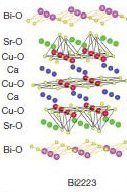 Finding a way to achieve a higher transition temperature, Tc, of a superconductor than it already has for the energy application is a grand challenge. Currently, copper oxides remain the superconducting materials having the highest Tc both at ambient condition and under pressure. EFree neutron scientist Xiao-Jia Chen (Carnegie), and collaborators present an experiment that achieved a remarkable Tc enhancement in a trilayer cuprate superconductor Bi2Sr2Ca2Cu3O10+δ at higher pressures.
Finding a way to achieve a higher transition temperature, Tc, of a superconductor than it already has for the energy application is a grand challenge. Currently, copper oxides remain the superconducting materials having the highest Tc both at ambient condition and under pressure. EFree neutron scientist Xiao-Jia Chen (Carnegie), and collaborators present an experiment that achieved a remarkable Tc enhancement in a trilayer cuprate superconductor Bi2Sr2Ca2Cu3O10+δ at higher pressures. Their results indicate that one can still make higher Tc in such materials through pressure-driven phase competition, which have important implications for designing and engineering superconductors with much higher Tcs at ambient conditions. They found that the higher transition temperature can be induced under two different intense pressures. They believe this unusual two-step phenomenon comes from competition of electronic behavior in different kinds of copper-oxygen layers in the crystal.
This research involved the Carnegie under DOE EFree and CDAC funding, in collaboration with colleagues from South China Institute of Technology and the Max-Planck Institute. It targets the DOE Grand Challenge: How do remarkable properties of matter emerge from complex correlations of the atomic or electronic constituents and how can we control these properties? It is also in the DOE Science Thrust Area of Superconducting, electronic, and magnetic materials [X. J. Chen et al., Nature 466, 950 (2010)]. doi:10.1038/nature09293 (August 19, 2010)
